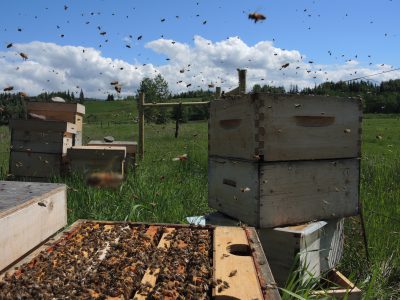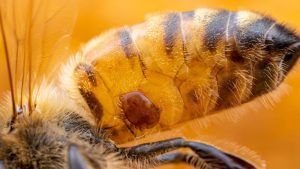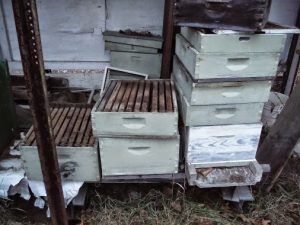
- Leaving your extracted frames out for everyone to clean up.
“One treatment free colony ( or someone who purposely lets their varroa infested colonies swarm) is potentially polluting the other apiaries within a gigantic flight range. (And robbers will go even further, out to 8 miles during dearths if someone leaves their doors open on a sick colony that has resources free for the taking. (… and they claim the“yellow jackets” killed their hives) I really don’t know how to get these numskulls educated.”
As you say, that is the crux of the problem. Even WITH treatment you will always have some Varroa. To summer extract (and or leave cardboard bait hives out) and then have an open house, ‘eat till you drop’ from your frames invites robbers from MILES away. Screw all your own prevention attempts, and forget all hope for caring for your own girls in a careful manner.

I wish I had time to speak more about mites in nursery applications, but it mirrors the problem with bee mites.
1. The longer your greenhouse or nursery is in operation the ‘dirtier’ it becomes. Disease and insects find a threshold and will thrive unless mitigated.
2. Your treatments become less effective over time
3. Mites become more resistant despite your best efforts to alternate treatments. Chemical spray, then an organic, then say Neem oil. …
Unless as in my orchid greenhouse you actually dip the plants pots and all in the chemical and soak down the wood benches (rarely done)… mites always survive.
We used mist foggers as well, but no matter the placement and movement to different aisles, you will miss a corner or air circulation will defeat you.
Old fashioned beekeeping may not be the answer but being attentive to your hives and NOT doing things that mess things up, like over packing your apiary. (drift from stacked or not well spaced hives or having the same colored hives)
 An example picture of pure neglect … but all too often seen. These slum hives and or cardboard box trap hives also serve as rooming boards for weak and infected colonies which in turn infect our own.
An example picture of pure neglect … but all too often seen. These slum hives and or cardboard box trap hives also serve as rooming boards for weak and infected colonies which in turn infect our own.
Inviting robbery after extraction is probably the stupidest thing one could do.
More intuitive answers such as the screened bottom with a larger (higher) entrance opening also helps. It is always nice to know that your bees do not have to trudge through the mite infested outhouse on the bottom of wood boards. Issue being winter and mice. Easy to solve with a new height restricted entrance reducer.
Side note: an invite to a friend to bring a hive over. At the moment I have only one super active hive and two that are questionable. I will not put them out in the open behind the barn as that is where the potential herbicide drift from a neighbor may happen again.
That brings me to the other issue. Varroa is winning the fight because the victim is beset by a multi legged set of other issues.(I decided to totally destroy that hive by the barn and had to burn all the frames and honey.) 😡
1. Insecticides, herbicides, fungicides weaken their natural immune system.
2. The building and structure of our hives themselves – painted interiors – shellacked top covers and too thin walls for winter protection
3. The inept moving them about too much … ‘Gee where am I today’? That does not happen in nature except in a catastrophe.
4.The increase in electronic pollution. the transmission of high intensity radiation from cell phone transmissions. the WI-fi issue does affect birds, bees and other insects (as does light pollution for insects like fireflies) 5G may make it worse.
5. The ever increasing loss of genetic diversity as shown in yesterday’s presentation. the bees in America have a woefully inbred and limited genetic diversity when compared to the Old world. Worse yet with these packaged bees we are hell bent on reducing it more … despite the work that people like Sue Colby do.
** at 200.00 a pop mind you!!! for the pollination fee they get.
HONEY in the bank for China and why American beekeepers are in such trouble.

Beekeeping and the purchase of packaged bees. The local farm stores will soon be offering packaged bees with queens. Your choice. Carnolian or Italian.
As a beekeeper of over 40 years I strongly suggest that you do NOT buy the Italian bees as they are not suited for our climate. Carnolian bees are.
For the usual price of 130.00 you are better off buying NUKS for 150.00. These will actually be cheaper as you are buying frames (hardware) that you do not get with packaged bees.
Locally raised nucs are always better. The queens will be uncaged and are already actively laying. This is a marked difference from caged queens that are mass produced and artificially inseminated. The accompanying 3 lbs of bees are not attendant bees but usually are vacuumed up worker bees at the end of their lifespan and will have to learn to accept the new queen. Or NOT!
The odds of successful overwinter of packaged bees is very low as caged queens may not be accepted by the accompanying packaged bees. An established NUK (usually 150.00) will have a queen already laying and will grow much more rapidly than a packaged bee colony… IF it survives, entirely because the bees already know her as their own.
A final choice might be a mated queen with say a frame of nurse bees (about 85.00) Make sure you get instructions whatever you decide and join the local bee club. NOPBA. https://www.nopba.org/
More on how packaged bees are made. https://drive.google.com/file/d/1Cq1S41_ecTBNlT2ONhgict8GqKJe3FK0/view
What can you wear not to have bees attack you?
Bees are very sensitive to movement and patterns. Wearing one color clothing is the best choice for you. White is the basic standard for bee suits, seen more as a gray or soft charcoal by the bee. Blending in to your environment also works. If you are in a desert surrounding that a soft sandy color would make sense as would khaki in a leafy setting.
I would think that wearing a black and yellow combo might not be a good idea as you would simply look like a giant wasp. Sure to get stung.
Wearing light colors smooth in texture, cotton is the best bet. No woolen or corduroy or fibers that may absorb and hold body odors. Wool is especially bad for this. Same thing for wearing any form of cologne, perfume or alcoholic drink.
Hats are needed simply to avoid them getting entangled in your hair and all clothing accouterments that are stung will hold those attack pheromones and encourage further attack. Hence the choice for fabrics that can deter bee sting penetration.
Last thought, wash your clothing and bee suit in a non perfumed soap or shampoo. Always do this as the smells from former attacks will stay in fabrics for a long time.
Now to test this out in my BRIGHT ORANGE prison jumpsuit my daughter just sent to me. Cotton and polyester with a liner. Great for winter but not something I would want to wear in warm weather. Now the light silver gray nylon polyester one might serve me very well.